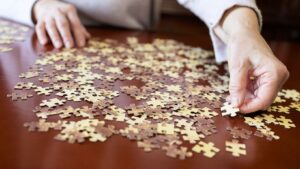 Puzzle Games have taken the world by storm, blending entertainment with cognitive challenges that captivate players of all ages. These games, which require assembling fragmented images into a coherent picture, offer a delightful way to test one’s problem-solving skills and attention to detail. Whether played on a smartphone or a traditional jigsaw board, picture puzzles provide a satisfying sense of achievement upon completion. In an era where digital distractions are rampant, Puzzle Games stand out by offering a calming yet stimulating experience. They encourage players to take a break from their hectic routines and immerse themselves in a task that sharpens their minds. Ideal for solo play or group activities, these games are more than just a pastime—they’re a brain-boosting exercise that combines fun with mental agility.
Puzzle Games have taken the world by storm, blending entertainment with cognitive challenges that captivate players of all ages. These games, which require assembling fragmented images into a coherent picture, offer a delightful way to test one’s problem-solving skills and attention to detail. Whether played on a smartphone or a traditional jigsaw board, picture puzzles provide a satisfying sense of achievement upon completion. In an era where digital distractions are rampant, Puzzle Games stand out by offering a calming yet stimulating experience. They encourage players to take a break from their hectic routines and immerse themselves in a task that sharpens their minds. Ideal for solo play or group activities, these games are more than just a pastime—they’re a brain-boosting exercise that combines fun with mental agility.
Picture Puzzle Game
Historical Background
Puzzle Games date back to the 18th century. The first known puzzles, called “dissected maps,” were created by John Spilsbury, a London engraver and mapmaker, in 1760. These early puzzles were used as educational tools to teach geography. By the 19th century, puzzles became popular recreational activities, evolving into the form known today. Advances in printing and die-cutting techniques during the 20th century further enhanced the quality and variety of picture puzzles available, cementing their place in popular culture.
Popularity and Trends
 In recent years, the Puzzle Game category has seen a resurgence, partly fueled by the rise of mobile gaming. Platforms like the App Store and Google Play host thousands of Puzzle Game apps that cater to various skill levels and age groups. For instance, apps such as “Jigsaw Puzzle” from Critical Hit Software and “Magic Jigsaw Puzzles” by ZiMAD rank among the top in downloads and user ratings. Social media also contributes to the trend, with users sharing their completed puzzles and challenging friends. Even traditional physical puzzles have seen an uptick in sales, especially during times when people seek indoor activities. The trend clearly indicates that Puzzle Games remain a beloved pastime, merging entertainment with cognitive exercise.
In recent years, the Puzzle Game category has seen a resurgence, partly fueled by the rise of mobile gaming. Platforms like the App Store and Google Play host thousands of Puzzle Game apps that cater to various skill levels and age groups. For instance, apps such as “Jigsaw Puzzle” from Critical Hit Software and “Magic Jigsaw Puzzles” by ZiMAD rank among the top in downloads and user ratings. Social media also contributes to the trend, with users sharing their completed puzzles and challenging friends. Even traditional physical puzzles have seen an uptick in sales, especially during times when people seek indoor activities. The trend clearly indicates that Puzzle Games remain a beloved pastime, merging entertainment with cognitive exercise.
Features of Puzzle Games
Visual Design
Puzzle Games captivate players with detailed, vibrant images. High-resolution graphics make the puzzles engaging and visually appealing. Games often feature a variety of themes like landscapes, animals, and artwork to cater to diverse interests. Attention to color accuracy and image clarity ensures an enjoyable user experience. Additionally, intuitive interfaces and easy navigation contribute to player satisfaction.
Gameplay Mechanics
 Gameplay mechanics in Puzzle Games emphasize user interaction and mental challenge. Players assemble pieces by matching patterns, shapes, and colors. Difficulty levels offer a range of complexity, accommodating both beginners and experienced players. Features like rotation and hint systems enhance gameplay, providing additional layers of challenge and assistance. Time-tracking elements and scoreboards introduce competition, motivating players to improve their skills and performance. By the 19th century, puzzles became popular recreational activities, evolving into the form known today. Advances in printing and die-cutting techniques during the 20th century further enhanced the quality and variety of picture puzzles available, cementing their place in popular culture.
Gameplay mechanics in Puzzle Games emphasize user interaction and mental challenge. Players assemble pieces by matching patterns, shapes, and colors. Difficulty levels offer a range of complexity, accommodating both beginners and experienced players. Features like rotation and hint systems enhance gameplay, providing additional layers of challenge and assistance. Time-tracking elements and scoreboards introduce competition, motivating players to improve their skills and performance. By the 19th century, puzzles became popular recreational activities, evolving into the form known today. Advances in printing and die-cutting techniques during the 20th century further enhanced the quality and variety of picture puzzles available, cementing their place in popular culture.
Benefits of Playing Puzzle Games
Cognitive Skills Development
Puzzle Games enhance cognitive skills by requiring players to employ critical thinking and problem-solving. They stimulate the brain, fostering recognition and memory retention as players match different pieces to form a complete image. A study in Frontiers in Aging Neuroscience (2018) demonstrated improved cognitive function in older adults engaged in puzzle activities. These games also develop spatial reasoning, as players visualize and manipulate pieces to fit them into the puzzle’s structure.
Stress Relief and Relaxation
Playing Puzzle Games offers stress relief and relaxation. Engaging with puzzles can lead to a meditative state, reducing anxiety levels. The repetitive action of fitting pieces together provides a sense of control and accomplishment. According to a report by the American Journal of Play (2019), puzzles induce a calming effect similar to mindfulness practices, promoting mental clarity. This mode of entertainment allows individuals to disconnect from daily stressors and immerse themselves in a focused, rewarding activity.



